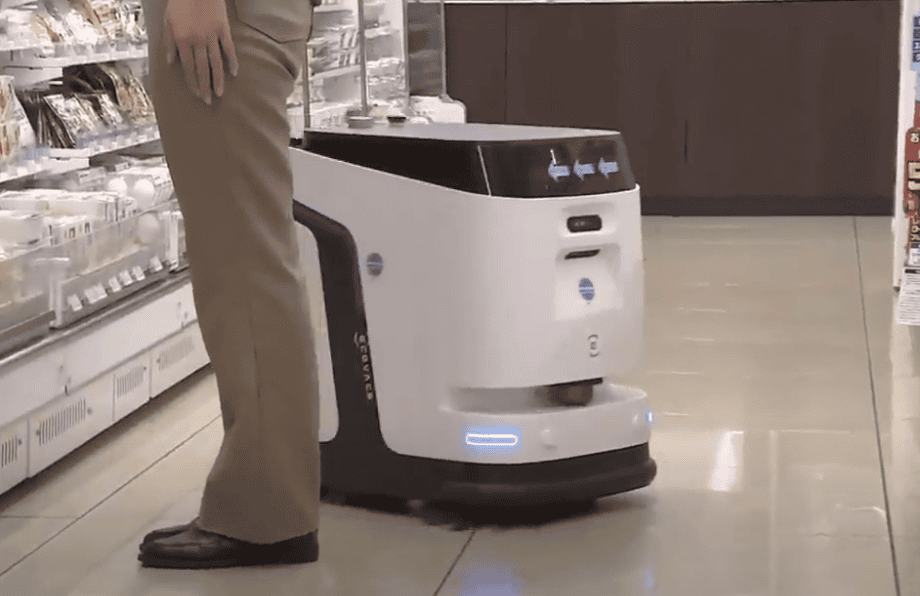A new kind of convenience store shift
At a 7-Eleven in Tokyo, a new kind of night shift has begun. A compact machine glides along chilled cases, selects bottles and cans with a robotic arm, and slides them into neat rows. When traffic in the aisles dips, a cleaning unit polishes floors and wipes windows. A video screen near the register connects late night shoppers to a remote customer support agent. The scene looks futuristic, yet it is not a stunt. It is a response to a simple problem: Japan is running out of workers.
- A new kind of convenience store shift
- Why 7-Eleven is turning to robots
- Inside the store, what the machines actually do
- Robots on the sidewalk, delivery trials in Tokyo suburbs
- The wider retail race to automate
- Technology explained without the jargon
- Labor, customers, and the social trade offs
- Rules and timelines to watch
- What to Know
Seven-Eleven Japan launched a three month in store trial in the capital to test whether a small fleet of robots can take on routine, time consuming work and keep its stores running around the clock. The company is focusing on tasks that drain staff time, such as moving drinks from storage to refrigerated displays and routine cleaning. By the company’s estimate, employees spend one to two hours a day on beverage restocking alone. If the program delivers strong results, the retailer plans to expand the concept to more locations with a goal of cutting workload by roughly 30 percent, then reinvesting that time into customer service and fresh food preparation.
Japan’s 24/7 convenience stores, known as konbini, are community anchors that sell everything from hot meals to bill payment services. Keeping those doors open all night has grown harder as hiring dries up and labor costs rise. Automation is moving from the back room to the front of the store, not as a novelty but as a tool to keep daily life running.
Why 7-Eleven is turning to robots
Demographics sit at the heart of this shift. Around a third of Japan’s population is now over 65, and the working age population has been shrinking since the late 1990s. A 2023 study by Recruit Works Institute projected a shortfall of about 3.4 million workers by the end of this decade and roughly 11 million by 2040. International comparisons show Japan already relies heavily on industrial automation. The International Federation of Robotics ranks Japan fifth worldwide for robot density in manufacturing at 419 units per 10,000 employees. The new frontier is services, where most jobs are found and shortages are now most acute.
Policymakers and executives increasingly frame automation as a way to preserve output, not eliminate jobs. Analysts at the International Monetary Fund have pointed to Japan’s history of robotics adoption and found that, in many cases, automation coincided with higher productivity and steady employment in manufacturing. The focus today is the service sector, where productivity has lagged for years. Convenience stores are an ideal test bed, since they run nonstop, perform many repeatable tasks, and face persistent hiring gaps.
Inside the store, what the machines actually do
The Tokyo pilot assigns distinct roles to different machines. One unit is dedicated to stocking bottled drinks and canned alcohol in refrigerated cases. This target is deliberate because beverage replenishment eats up staff time, requires work in cramped, cold spaces, and must be repeated several times per day in busy stores. By offloading this work, supervisors expect to free up one to two staff hours daily for more visible tasks such as serving customers, preparing food, or tidying shelves outside the coolers.
Other units handle cleaning. These robots sweep and mop floors and polish windows, chores that tend to be postponed when stores are understaffed. The pilot also includes a remote customer service station. A screen at the register lets shoppers tap for live support from an off site agent during hours when a cashier might be on break or when fewer staff are scheduled. The aim is to keep the doors open and service consistent without requiring a full overnight team on site every day.
Hiroki Takei, head of operations at 7-Eleven, described the goal of the trial in a statement shared with local media.
We aim to increase productivity and create an environment where we can challenge ourselves to create new product assortments and services.
Company managers will track labor time saved, out of stock rates for drinks, and how shoppers respond to the new setup. If the data look good, wider rollout could begin, starting with high traffic urban stores where staffing is tight and cooler restocking loads are heavy.
Robots on the sidewalk, delivery trials in Tokyo suburbs
While the in store trial tackles tasks inside the four walls, 7-Eleven is also experimenting with small delivery robots on public sidewalks. In Hachioji, a suburb west of central Tokyo, the company is running a delivery pilot that covers roughly 10,000 households. Customers order through the 7NOW app, staff load the robot at the store, and the unit trundles along at walking speed, roughly 6 kilometers per hour, following traffic signals and avoiding obstacles. The target delivery window is about 20 minutes. When the robot arrives, the customer scans a QR code to open the compartment and retrieve the purchase. Remote supervisors monitor the robots and can take control if needed.
The company deliberately chose a hilly testing area with plenty of slopes to stress the machines and collect feedback from older residents. A company spokesperson explained the reasoning behind the trial location.
We deliberately targeted an area with slopes and an aging population to clarify the problems we would face ahead of putting the service into practical use.
The sidewalk test is scheduled to run into early 2026. Law changes in 2023 cleared the way for such pilots, allowing low speed delivery robots on public roads under strict rules on speed, monitoring, and safety. The project also addresses a truck driver shortage that has strained home delivery and last mile logistics across Japan.
The wider retail race to automate
Convenience chains across Japan are moving in similar directions. FamilyMart has been working with Tokyo based startup Telexistence to roll out an autonomous restocking system in hundreds of stores. The company’s TX SCARA model is engineered to operate inside beverage cases, moving along a rail to pick bottles and cans from storage and place them on shelves. The system can replenish up to 1,000 items per day and work around the clock. An AI platform analyzes shelf images and sales data to decide what to restock first, while depth and color sensors guide the arm. When something goes wrong, a remote operator can slip into teleoperation mode through a virtual reality console and correct the issue within seconds. FamilyMart pays for the setup as a robot as a service subscription rather than buying the machines outright.
Lawson, another major chain, has tested teleoperated shelf stockers and has explored expanding trials as systems become more autonomous. The approach is pragmatic. Teleoperation lets developers collect training data and handle edge cases while stores benefit from labor flexibility. Remote operators can log in from anywhere, opening the door to workers who cannot commute or prefer flexible hours.
Outside convenience retail, delivery robots have been trialed by companies in e commerce and electronics, reflecting a broader search for ways to keep services running with fewer drivers and store staff. The momentum in 2025 reflects years of incremental testing that moved robots from novelty displays to tools that handle specific, repeatable jobs.
Technology explained without the jargon
In store shelf stockers are built for one purpose. Cameras scan the cooler, compare what they see to a store planogram, and spot gaps on the shelf. Software ranks items by urgency, taking into account past sales and time of day. The robot slides along a guide rail, reaches into a storage bin, grips a bottle or can at a calculated pick point, and places it in the right slot. If it detects an anomaly, such as a fallen item or a blocked bay, it alerts a human overseer. That mix of autonomy for routine steps and quick human intervention for odd moments keeps errors low without requiring full time on site supervision.
How shelf stocking AI works
Systems in this class typically run multiple vision models at once. One model identifies products, another estimates depth to guide the arm, a third flags empty slots or misplacements, and a fourth checks for anomalies. Developers train these models with a blend of real store footage and synthetic images generated in simulation. The software runs on compact edge computers placed inside the machine, so it can make decisions in the moment even if a network link is slow. Store data, such as sales history and inventory targets, flows to the robot from the cloud to refine priorities and reduce out of stock events.
What keeps delivery robots safe
Sidewalk units use a different stack. They rely on lidar and cameras to perceive curbs, pedestrians, and pets, follow traffic signals at crossings, and plan a path that avoids obstacles. Sensors watch for sudden movement. If a child darts in front, the robot stops. Safety protocols limit speed to walking pace, and every robot is linked to a remote hub where human supervisors can step in during confusion or if a route is blocked. The combination of low speed limits, geofenced routes, and human backup is designed to reduce risk while the technology matures.
Labor, customers, and the social trade offs
The biggest difference between the debate in Japan and debates elsewhere is context. Many executives are not trying to replace workers. They are trying to keep shifts covered when they cannot find enough staff. The country’s demographic math points in one direction. There will be fewer working age people in the years ahead, and stores still need restocked shelves and clean floors. Robots can fill gaps and let staff focus on tasks that require judgment and empathy, such as helping an elderly customer, handling a return, or building a local menu.
Some labor voices caution that automation’s effects will vary by workplace and skill. Niki Harada, an official at Japan’s Restaurant Workers Union, described the open question facing service jobs.
It is difficult to tell now what impact robots might have in restaurants, it could mean fewer people, but it could also create new jobs.
For customers, the experience may feel slightly different during quiet hours. A remote support agent on a screen might handle a complex payment or age verification, while a robot tidies nearby. The best case is fewer empty shelves and faster delivery for those who need it most. The trials in Hachioji are aimed at older residents who struggle with hills and heavy bags. If the robots prove reliable, they could turn nearby convenience stores into micro hubs for same day essentials.
Concerns remain. Sidewalk robots must navigate tight spaces, unruly weather, and occasional vandalism. Privacy is a factor because vision systems capture images of public spaces. Retailers and municipalities will need clear rules for data retention, reporting of incidents, and insurance. The low speed, human in the loop setup lowers risk, yet operators will need to show that performance stays safe as fleets grow.
Rules and timelines to watch
A key shift came in 2023 when Japan allowed low speed delivery robots on public roads under specific conditions, including remote monitoring, audible alerts, and strict speed caps. This legal change moved delivery pilots from private campuses to real neighborhoods. Cities and police departments now coordinate with retailers on test routes, crossings, and operating hours. The framework resembles rules for slow mobility devices and focuses on minimizing conflicts with pedestrians.
7-Eleven’s in store trial runs for about three months before the company decides whether to expand the format to more locations. The sidewalk delivery test in Hachioji is scheduled through early 2026. Executives will weigh reliability, customer uptake, and the cost per delivery against wage and fuel prices. Hardware costs tend to fall as production scales, while software improves as systems learn from more hours on the job. The pace of rollout will depend on whether the trials consistently reduce workload and keep service quality high.
What to Know
- 7-Eleven is testing robots in a Tokyo store to restock drinks, clean floors and windows, and support shoppers through a remote service screen.
- The company will evaluate the store trial over about three months and aims to cut employee workload by around 30 percent if the approach expands.
- Sidewalk delivery robots are on trial in Hachioji, serving roughly 10,000 households with orders placed through the 7NOW app and arrival targeted in about 20 minutes.
- Delivery units move at walking speed, follow traffic signals, and are remotely monitored so human supervisors can intervene when needed.
- A 2023 rule change permits low speed delivery robots on public roads, unlocking real neighborhood tests under strict safety conditions.
- Japan faces a severe worker shortage, with projections of a 3.4 million labor shortfall by 2030 and about 11 million by 2040, which is pushing retailers toward automation.
- FamilyMart has already deployed autonomous shelf stockers across hundreds of stores, showing how drink replenishment can be automated at scale.
- These systems blend autonomy with remote human control, using cameras and AI for routine tasks and teleoperation to handle edge cases.
- Retailers are using robots to supplement scarce staff, keep 24/7 stores open, and improve availability for older customers who struggle to shop in person.
- The success of the trials will hinge on reliability, safety in public spaces, customer acceptance, and whether the economics beat traditional staffing and delivery.




